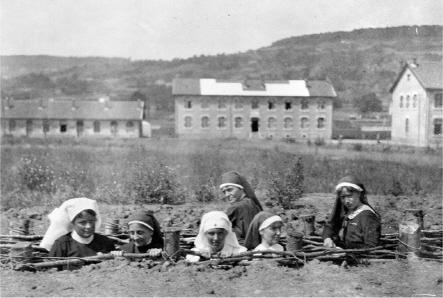The Other Anzacs (48 page)

Nurses and patients at the New Zealand Stationary Hospital, Wisques. Once they reached a stationary hospital, the wounded troops received more permanent care than was available in advanced or casualty clearing stations. (Courtesy of the Royal New Zealand Returned and Services’ Association Collection, the Alexander Turnbull Library, Wellington, NZ, G-13470-1/2)
With the Battle of Fromelles imminent, Lieutenant Harry Moffitt hurriedly wrote this letter to his sweetheart, Sister Alice Ross King. (Courtesy of Marion Sanders)


An advanced dressing station, the Ypres Salient, the Western Front, 19 October 1917. A wounded soldier lies on a stretcher on the muddy ground, while his compatriots gather around an ambulance. The wounded were treated here straight from the battlefield, before going on to casualty clearing stations. (Photo courtesy of the Royal New Zealand Returned and Services’ Association Collection, the Alexander Turnbull Library, Wellington, NZ, G-012928-1/2)
A graphic example of the horrific wounds troops suffered and that doctors and nurses had to deal with. Here, a French surgeon and an English nurse working with the Australian Bluebirds study the sutured leg of a wounded French soldier. (Photo courtesy of the Australian War Memorial P01908.026)


An operating theatre of the 1st Australian Casualty Clearing Station. Surgeons and nurses made do with what they had. Note the bucket for waste underneath the operating bed and the heater to its side. (Photo courtesy of the Australian War Memorial E01304)
Bluebird sister, Dorothy Duffy, is seen here acting as an anaesthetist while a surgeon and his assistant operate at French Hospital No. 46 at Beziers on 20 March 1918. (Photo courtesy of the Australian War Memorial P02298.008)


Sister Lynette Crozier and a medical orderly apply a dressing to the leg of a wounded French soldier at a mobile hospital established by Mrs Borden Turner south-west of Amiens. (Photo courtesy of the Australian War Memorial P01790.001)
Sisters Annie Shadforth (left) and Margaret Nisbet (centre) standing in the acute surgical ward at the 1st Australian General Hospital, Rouen, France. The tall beds on the right were for the elevation of limbs. (Photo courtesy of Des Ryan)


Bluebird, Sister Minnie Hough, poses wearing a gas mask — an apparatus that became all too common for nurses in France. (Photo courtesy of the Australian War Memorial P01908.017)
Matron Ida O’Dwyer, wearing her service medals. After enlisting on 21 November 1914, she served in Egypt, in England where she was in charge of the Nurses’ Hospital in London, and in France where she was the Head Sister of No.3 Australian Casualty Clearing Station. One of her duties was to write letters to the mothers of men who had died. (Photo courtesy of the Australian War Memorial P00848.002.)


Bluebird, Sister Hilda Loxton (third from left), familiarises herself with a slit trench in the grounds of a French military hospital during a visit to Essay in 1917. (Photo courtesy of the Australian War Memorial P01790.002)
Two nurses from No. 2 Australian General Hospital at Wimeraux, France, stand at the entrance to the nurses’ dugout. The hospital experienced many air raids. (Photo courtesy of the Australian War Memorial H04152)
